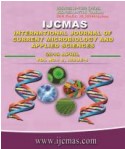


 National Academy of Agricultural Sciences (NAAS)
National Academy of Agricultural Sciences (NAAS)

|
PRINT ISSN : 2319-7692
Online ISSN : 2319-7706 Issues : 12 per year Publisher : Excellent Publishers Email : editorijcmas@gmail.com / submit@ijcmas.com Editor-in-chief: Dr.M.Prakash Index Copernicus ICV 2018: 95.39 NAAS RATING 2020: 5.38 |
Water scarcity and increase wastewater generation are twin problem associated which needs to be addressed to derive benefit for agricultural production. In this context laboratory study was conducted to characterize the wastewater from four different sources (Ugar sugar-Ugar khurd, West coast paper mill-Dandeli, Nectar beverages-Dharwad, Domestic sewage water-UAS campus Dharwad) in north Karnataka and were compared with freshwater. Spentwash from the Ugar Sugar Works distillery was singularly different from rest of the wastewaters and was characterized by its high pH, EC, TSS, TDS, BOD, COD, total nitrogen, phosphate, potassium and sulphate concentration. The effect of the wastewaters on the dominant soils of north Karnataka (Red, Lateritic and Black soil) were evaluated in column study during March-2014 to April-2015. Wide variation in water characteristics was recorded with wastewaters studied. The concentration of heavy metals increased in soils from 4 to 8 pore volumes application of various wastewaters. The highest lead concentration was observed in W4. The effect of different wastewaters in enhancing the lead concentration was highest in the black soil followed by red and then by lateritic soil. The concentration of chromium in spentwash treated soils at both 4 and 8 pore volumes passage was not only highest but singularly different from the rest.
 |
 |
 |
 |
 |